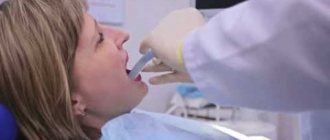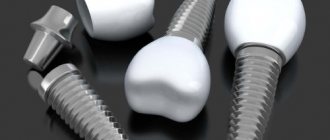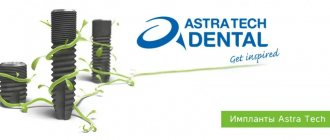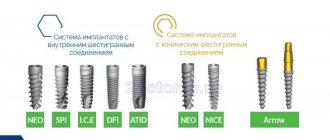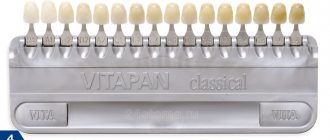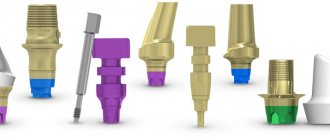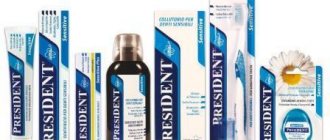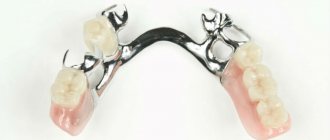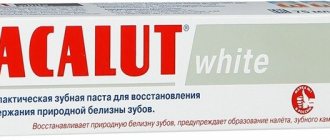Installation of dental implants is a very popular service, since such dental prostheses can solve problems with missing teeth in a person’s mouth for many years. Due to the fact that many people today have dental implants installed, there is a wide variety of models of dental structures offered by manufacturers from around the world.
This month, installation of one implant costs 17,990 rubles.
The choice of dental implant prostheses, which can be installed in the patient’s mouth, is certainly large. And it can be difficult for a person to find a suitable dental implant, since many nuances need to be taken into account, and it is not always possible to understand the topic on their own. This is one of the reasons why patients are afraid of the dental implant procedure in the mouth. In order to dispel your doubts and clarify the issue of installing implants, the LeaderStom network of dental clinics in this article will talk about popular models of dental structures, prices for their installation and consumer reviews regarding the use of permanent dentures produced by Osstem.
History of the development of Osstem from South Korea
In the 90s, South Korea experienced rapid economic and industrial growth, most of all this affected the sphere of high technology and medicine. Today, South Korean companies are among the leading suppliers of equipment and technological solutions for dentistry in general and implantology in particular. As for the Osstem Implant System company itself, it is one of the largest players not only in the Asian but also in the world market.
The company was founded in 1992 and is considered one of the pioneers in the development and production of dental implants in Korea. However, the year of foundation does not mean that the first implant was released in 1992. The industrial license was received only in 1995, and commercial production of Osstem Implant System products started in 1997. The long journey of development and testing paid off: by the mid-2000s, the company had released two lines of implants that were in demand among specialists and managed to enter the American market. Today its products are represented in more than 50 countries. Osstem implants, patient reviews confirm this, are a high-quality and reliable implantation system.
Types of Ostem implants
The current director of the company is a man with the name Kyoo-Ok Choi, which is difficult to pronounce for a Russian person. A former dental practitioner himself, Kyoo-Ok Choi states that clinical research and the production of universal and reliable implants are of particular importance to his company. The manufacturer produces several lines of implants that differ in size, shape, and thread. They are specially manufactured for all types of jaw bone, which allows the implant surgeon to select the optimal product for any patient.
TS system
Osstem TS implants are the most versatile Osstem system, which includes 3 types of implant designs for various clinical cases and bone types, as well as SA and CA surface variations. The manufacturer claims a high degree of primary stabilization in the bone. These implants can be installed using a simplified protocol. Distinctive features: double corkscrew thread, triple connection to the abutment.
The surface of all Osstem TS SA implants is treated using physical methods (sandblasting with fine aluminum particles plus acid etching). The engraftment period is 6-8 weeks.
TS III SA.
The most universal system due to a wide range of sizes. They have a conical shape that allows the use of simplified protocols when Osstem implants are installed. Reviews from doctors confirm that they are suitable for complex clinical cases, for example, sinus lift with one-step installation for bone heights up to 4 mm.
TS III CA.
TS III implants with a chemically treated hydrophilic surface: the implant is packaged in an ampoule with a CaCl2 solution. Due to hydrophilicity, the surface of the implant immediately after installation attracts a layer of blood and proteins, which ensures primary stability and rapid survival. The healing period in the jawbone is 3-4 weeks, which significantly exceeds the performance of classic implants with a traditional milled surface.
TS IV SA.
Due to their pronounced conical shape and excellent self-cutting ability, they are well stabilized even in soft bone. They are used for installation in soft bone conditions, in particular for sinus lifting.
TS II SA.
Osstem TS II implants are cylindrical in shape and designed specifically to work in dense bone conditions. Fine threads in the area of the implant neck protect against bone overheating and relieve stress on the cortical bone during implant installation and operation.
ET III SA system
These implants are produced in the USA by Osstem's partner, Hiossen Implant. They have a sandblasted SA surface, diameters vary from 2.5 to 7 mm, and the implants themselves are compatible with all kinds of standard abutments. This gives the implantologist the opportunity to accurately select the product for any patient who chooses Osstem implants. Reviews from doctors prove that the entire line is excellent for aesthetic restorations.
MS system
This is a line of solid implants (when the implant is connected to an abutment) for restoring teeth in non-standard situations: when there is a lack of bone tissue volume, as well as when installing artificial roots with immediate loading with prostheses.
Osstem MS is temporary.
Used for temporary implantation with immediate loading. Temporary implants and prosthesis last up to six months and are installed between the holes of permanent implants.
Osstem MS for narrow alveolar ridge.
The narrowest implants (diameter 2.5 - 3 millimeters) for installation in bone with limited volume. Often restorations take place in the frontal region of the jaw.
Osstem MS for removable prosthetics.
This model has a ball-shaped mount for installing a removable denture. The system is distinguished by a simplified treatment protocol and the possibility of prosthetics for completely edentulous one of the jaws.
Installation process
The implantation of a denture structure occurs in one or several stages.
A quick method is one-step implantation. In this case, immediately after amputation of the tooth, a titanium rod is inserted into the socket. As soon as it takes root, the prosthesis is secured. The Osstem company offers 2 more methods - classic and 4D technology. Their features:
- Implantation in the classical way occurs in 2 stages. First, install the rod. After healing, which takes approximately 1.5 months, a permanent crown is attached. The patient chooses the material.
- 4D technology is designed to eliminate the need to build up bone tissue. It is indispensable in cases where your own bone is too small or has a soft structure. Due to the special fastening, the product is fixed very firmly. Already 3 days after implantation, a crown can be installed.
Osstem Implant coating
Ostem implants are available with several types of coatings. None of them can be called special or innovative, because in many ways they duplicate coatings that have been developed and used for a long time. By the way, company representatives gave each coating its own abbreviation in order to distinguish them from the rest.
S.A.
The coating used on most Osstem branded implants. This is an analogue of SLA - the most popular modern coating for implant systems. Like SLA, SA is produced by sandblasting followed by acid etching.
SA.
A more modern type of hydrophilic surface, which provides better wettability of the implant surface with blood, thereby reducing the risk of implant rejection and reducing the time of osseointegration.
HA.
Essentially, this is an upgrade to the SA surface - an additional layer of hydroxyapatite, which, according to the developers, increases the primary stability of implants.
Features of Osstem implantation
Installation of the Osstem implant occurs in exactly the same way as in the case of other systems: implantation of the titanium root takes place according to a one-stage or two-stage (in most cases) protocol. We should not forget about the absolute contraindications to the procedure itself, in the presence of which the installation of Osstem implants (as well as any other) is impossible.
To work with various clinical cases, Korean Osstem implants have an appropriate orthopedic portfolio. Each manufactured Osstem abutment and additional prosthetic components are designed for different types of restorations: it can be either the replacement of one missing tooth or the restoration of fragments of the dentition and the entire jaw.
Dental implantation Osstem (Korea) – pros and cons
- Good value for money.
- Quite an extensive product line.
- A recognizable brand whose implants are used in many clinics. During its existence, the company has accumulated cases with long-term treatment results.
- A good system of supporting clinicians with educational courses and seminars.
- Osstem implants do not have any great competitive advantages over systems of similar class.
DIO Implants
The Korean dental implant presented above is not popular in the Russian Federation, and it is almost impossible to find patient reviews about it. The key feature of these dental implants is the presence of the Bio Tite-H surface, which is created by German specialists. Due to this coating, it is possible to significantly shorten the engraftment period, as well as minimize the likelihood of peri-implantitis and allergic reactions. Moreover, the designs of this brand have a Tors connection, which simplifies the process of fixing the adapter and prevents its loosening.
Another feature of Dio dental systems is the simplified bonding process. However, their use is not intended in difficult situations.
This Korean dental implant has a reasonable price. At the same time, in the manufacturer’s arsenal one can find both traditional root-type structures and mini-implants for installing removable prosthetic devices in the frontal area. Narrow Fix systems are used to fix fixed bridge structures in the narrow part of the alveolar process.
Which implants are better than Alpha Bio, Osstem or Dentium?
It's no secret that any implantological system tries to position itself from the best side, including in relation to competitors. This is especially true for economy class manufacturers, between whom there is particularly intense competition. At the same time, it is quite difficult to definitely say which implants are better: Alpha Bio or Osstem. These are two approximately equal manufacturers. Here it is better to talk about the preferences of the specialists themselves: some prefer Korean systems, while others are more accustomed to working with Israeli ones.
If we talk about Dentium and Osstem implants (Dentium is another popular Korean system and the main competitor of Osstem), then here you need to compare specific lines. In terms of their characteristics, implants from the Dentium Implantium line do not benefit in any way, and perhaps in some ways they are even inferior to Osstem implants. The Dentium SuperLine system is of higher quality and status, therefore it is considered better than standard implants from Osstem. Be that as it may, it still cannot compete with leading brands (Nobel Biocare, Straumann), but at the same time it costs much more than other economy class lines.
What methods of dental restoration are used?
It is important to emphasize that Osstem are systems for which expert reviews are mostly positive, also because they have wide application possibilities. That is, they are suitable for different clinical cases and implantation protocols: classical two-stage technology with delayed loading, one-stage methods with delayed and immediate loading on 4-6 artificial roots to restore all teeth in the jaw, one-stage protocol with the removal of teeth and their simultaneous replacement with implants. True, many are in no hurry to work with them specifically in immediate loading protocols, since the restrictions for their use are tens of times greater than when using the original models of the Nobel Biocare brand. But as practice shows, this brand can still be considered as an inexpensive alternative for the comprehensive restoration of all teeth on implants.
Osstem takes care of different categories of patients. Thus, the same artificial roots with an ultrahydrophilic surface are recommended for people with minor periodontal inflammation and hormonal disorders.
“I’ve never heard of these before, but the doctor at the clinic suggested them. The option turned out to be good for the price. I was surprised that my decayed tooth was removed, and Osstem was immediately installed in its place. Everything is very fast. As for the quality, I can only evaluate it later, because now only a month has passed since the operation. Immediately after the operation there was slight swelling and pain, but now everything is fine. The doctor says that in a couple of months it will be possible to install a crown.”
Maria K, review from 32top.ru
How much do Korean Osstem implants cost?
As a rule, the price for Osstem implants in Moscow is determined by the model, the complexity of the clinical case, and the level of the clinic in which the treatment is performed. Thus, implantation with Osstem TS SA costs on average 19,000 - 23,000 rubles. As a result, the price of the finished structure with a metal-ceramic crown will be about 30,000 - 35,000 rubles, and with a zirconium crown - approximately 40,000 - 45,000 rubles. Dental restoration according to the “All on 4” concept with Korean Osstem implants will cost 180,000 - 200,000 rubles for one jaw.
Advantages and disadvantages of the brand
Osstem are implants that, although of fairly good quality, have a low cost. So, installing one artificial root will cost about 30 thousand rubles. Together with the crown, the price will be higher - it can vary from 40 to 70 thousand rubles depending on the material of the crown (metal-ceramics will cost less, prosthetics with structures made of zirconium dioxide will cost the most). The product has only one significant drawback - in fact, it is a copy of an already well-known brands presented (in particular, Straumann and Nobel), there is nothing unique about it, but this copy is very thoughtful and high-quality, which is why a large number of patients and medical practitioners continue to choose it today. However, before treatment, you should be attentive not so much to this brand, but to the professionalism of the implantologist who will select and install artificial roots. If the specialist is qualified, then even budget brands will please you for a very long time.

